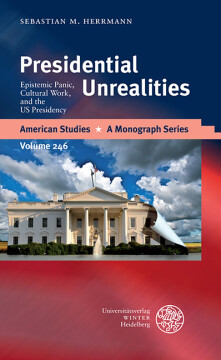
BUCH
Presidential Unrealities
Epistemic Panic, Cultural Work, and the US Presidency
American Studies – A Monograph Series, Bd. 246
2014
Zusätzliche Informationen
Bibliografische Daten
Abstract
This book analyzes and historicizes an important and popular motif in contemporary US political discourse: the notion that politics has become increasingly ‘unreal.’ At the turn of the millennium, the simulated quality of politics in general and of the US presidency in particular has become a major object of concern across a broad range of venues and media: publications in media studies and political science, newspaper editorials, novels, films, and TV shows alike worry over how much or how little we can actually know about the reality of the US president when all our knowledge is based on carefully staged media representations. Rather than adding another voice to this concern, ‘Presidential Unrealities’ investigates the cultural work such discussions do. Charting their histories and their cultural resonances, the book argues that debating ‘presidential unreality’ provides a crucial vocabulary by way of which the US public negotiates the postmodernization of American culture and society.
Inhaltsverzeichnis
| Zwischenüberschrift | Seite | Aktion | Preis |
|---|---|---|---|
| TABLE OF CONTENTS | 5 | ||
| Acknowledgments | 7 | ||
| Introduction | 9 | ||
| Prologue | 9 | ||
| Reading the ‘Fictitious President’ | 15 | ||
| No Textualization without Representation? Situating Presidential Unreality | 21 | ||
| Epistemic Panic, Fact Panic, and a Passion for the Hyperreal | 22 | ||
| Realisms: Discourses of Sobriety, Spectacles of Referentiality | 26 | ||
| The Politics of (Post-)Postmodernism | 29 | ||
| The Disciplinary Work(ings) of ‘Cultural Work’ | 32 | ||
| (New) American Studies | 33 | ||
| New Historicism | 35 | ||
| (Postclassical) Narratology | 37 | ||
| Conclusion | 39 | ||
| 1. Frames, Facts, and Fiction: Popular Narratology and Presidential Unreality | 41 | ||
| Introduction: Of Traveling Theories | 41 | ||
| Linguistic Unreality | 45 | ||
| Spinning Frames and Bouncing Facts | 45 | ||
| The Narrative Turn | 52 | ||
| Popular Narratology | 57 | ||
| A Tale of Presidential Storytelling: Frank Rich’s "The Greatest Story Ever Sold" | 63 | ||
| Rough Drafts of History: Instant Historiography and "Kulturkritik" | 65 | ||
| Authentication, Textual Authority, and Ambivalence | 69 | ||
| Crossovers and Collapses | 73 | ||
| Kidnapped Readers, Hijacked Stories: "The Librarian" and the Power of Narrative | 77 | ||
| Hitting Home in the Desert of the Real | 80 | ||
| Fog Facts and Sticky Tales | 84 | ||
| Getting the Narrative Right | 91 | ||
| Conclusion | 97 | ||
| 2. The Hyperreal and Its Appeal: Hollywood and ‘Californian’ Unreality | 101 | ||
| Introduction: The Reel and the Real | 101 | ||
| California Crossroads: The Uses of the Golden State | 107 | ||
| No There There | 110 | ||
| The Reel Troubles of Hard-Boiled Men | 114 | ||
| Frankfurt, CA: Kulturkritik, Iconoclasm, and the Dream Factory | 119 | ||
| Gaudy Games of Referentiality: "American Hero" as Satire | 123 | ||
| Telling Games: "American Hero’s" Narrative Setup | 126 | ||
| The Reel America vs. The Real America | 131 | ||
| Play-Boy? The Hard-Balled Detective as Inside Narrator | 135 | ||
| Tale Whacks Reality? "Wag the Dog’s" Take on Social Reality | 140 | ||
| “How Close Are You to This?” or: The Medium Is the Menace | 144 | ||
| “What Difference Does It Make if It’s True?” | 148 | ||
| “That Is a Complete Fucking Fraud. [...] It’s so Honest” | 153 | ||
| Conclusion | 158 | ||
| 3. Selling Images: Market(ing) Critique and the Graphic Revolution | 163 | ||
| Introduction: At Pennsylvania and Madison | 163 | ||
| Selling the Image | 166 | ||
| Social and Cultural Critique | 171 | ||
| The Market and the Public Sphere | 176 | ||
| The Rise of the Image | 181 | ||
| Selling Out: The Othering of the Image in "The Selling of the President 1968" | 186 | ||
| The Telling of the President | 191 | ||
| Resonances and Ventriloquism | 196 | ||
| Ambivalence and Othered Textualities | 202 | ||
| Defrosting the Image: The Nostalgia of "Frost/Nixon" | 209 | ||
| “Just Think of the Numbers It Would Get”: Truths and Audiences | 212 | ||
| “The First and Greatest Sin”: Ambivalences of the Image | 217 | ||
| “I Guess We Just Got Caught Up, You Know, Reminiscing” | 222 | ||
| Conclusion | 226 | ||
| Conclusion: Strange Coincidences, Powerful Collusions | 229 | ||
| Looking Back | 230 | ||
| Closing Thoughts | 232 | ||
| List of Works Cited | 237 |


 Publishing Platform by CloudPublish
Publishing Platform by CloudPublish